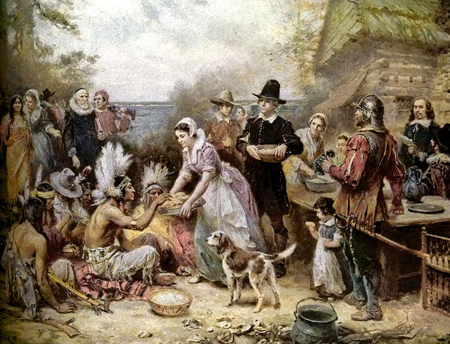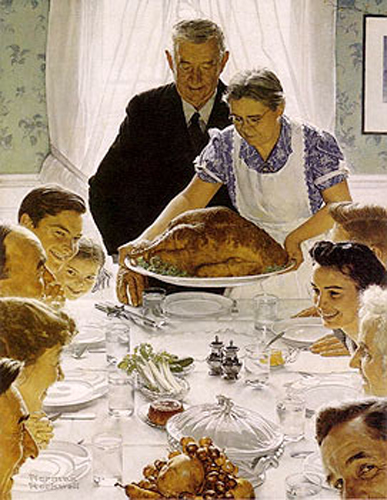
Jean Leon Gerome Ferris, "The First Thanksgiving," 1915, oil on canvas.
By Scot C Hart
The origins of Thanksgiving predate the Pilgrims by at least 2,000 years. After the harvest of each year was safely stored for the winter, Celtic priests would mark the end of their calendar with prayers to their sun god for protection during the period of darkness and cold of winter. These harvest festivals evolved and much later became combined with a Christian Feast of Saints.
But most Americans hark back only to the Pilgrims of Plymouth Rock holding their Thanksgiving in 1621 as a three day "thank you" celebration to the leaders of the Wampanoag Indian tribe and their families for teaching them the survival skills they needed to survive in the New World. Sounds too much like a Hallmark moment, but the vision of that day has been rooted deeply in our psyche not by historians, but by artists.
If you stop and think about it, you probably see Thanksgiving in a very visual manner. The holiday has been engrained into our memories from as early as grade-school, almost all of it based on presentations influenced by artistic renderings of the day.
Truth is, whenever a Pilgrim, or more accurately, a generic 17th-century Puritan image appeared in popular art in connection with Thanksgiving during the nineteenth century, it was not the now familiar scene of English and Indians sitting down to an outdoor feast. On the contrary, the image almost always portrayed a violent confrontation between colonist and Native American. It was only after the turn of the century, when the western Indian wars were over and the "vanishing red man" was vanishing satisfactorily, that the romantic, idyllic image of the two cultures sitting down to an autumn feast became popular. By the First World War, popular art (especially postcards), schoolbooks and literature had linked the Pilgrims and the First Thanksgiving indivisibly together, so much so that the image of the Pilgrim and the familiar fall feast almost ousted the landing at Plymouth and older patriotic images from the popular consciousness. This alliance also deflated Forefathers' Day, a holiday commemorating the landing, which sank in to insignificance even in Plymouth itself.
The Pilgrims held what they called a Thanksgiving, but you certainly couldn't say that they "celebrated" it: their idea of Thanksgiving was a full-day prayer session, thanking God for holding back from the smiting for a little while. There wasn't any revelry going on. By the late 19th Century, however, the American tradition of idealizing and revising the past was well underway, and Colonial Revival paintings of the First Thanksgiving eschew historical accuracy in favor of idealized icons of Americana.
"The First Thanksgiving" (1915), by Jean Louis Gerome Ferris (American painter, 1863-1930) is widely considered the most revered painting of the holiday. But historians have later said the black outfits the Pilgrims are shown wearing are wrong, and the Wampanoag did not wear feathered war bonnets, nor would they have been sitting on the ground.
Even more symbolically linked to the holiday is illustrator Norman Rockwell, an optimist at heart who painted the world not the way it was, but as he wanted it to be. His "Freedom from Want" (1943) painting was one of four that he made as part of a series inspired by a speech by President Franklin D. Roosevelt. What we find interesting about this painting is that Rockwell composed it in a way to make the viewer feel as if they were included in this moment, made so especially by the fact that the man at the bottom right is looking up, making eye contact with whomever might be standing in this room with this vantage point. And if "we" were there, then the image must be reality-based. Just like the Indians roasting turkey with their BFF, the Pilgrims.

Norman Rockwell, "Freedom from Want," 1943, oil on canvas, 45 3/4 x 35 1/2".
ArtScene and Visual Art Source are the in print and online resources to fine art galleries and museums in Southern California and the Western United States. Visit us online or pick up a copy for complete listings of art venues and editorial Reviews, Recommendations and Previews of the best current exhibitions. Be sure to visit our Openings Calendar page so you can plan visits to the latest exhibitions--of wherever you may be in the Western States.
Want to opt-in for a free subscription to stay current every day on our Weekly Newsletter, as well as new shows, events and (if you are an artist) artists' calls? It's easy.